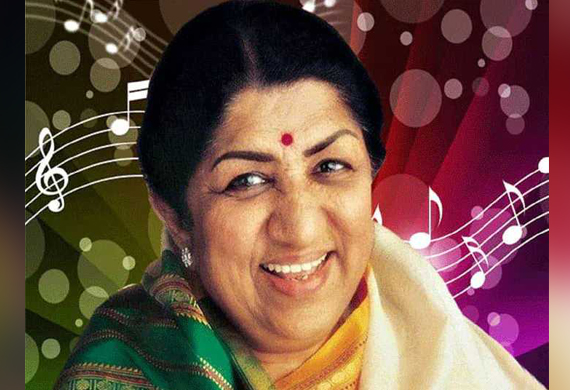
The Ode to the Nightingale of India, Lata Mangeshkar
By: Sruthi, Writer, WomenEntrepreneurIndia
Lata Mangeshkar, India's Nightingale, died unexpectedly at the age of 92, leaving behind a legacy of heartfelt music. The Bharat Ratna recipient died on February 6, 2022, from multi-organ failure.
Lata Mangeshkar was born in Indore, Madhya Pradesh, on September 28, 1929, to Pandit Deenanath Mangeshkar and Shevanti. Her unique voice and vocal range of more than three octaves characterise her. During her eight-decade career, she composed music for over 2,000 Indian film soundtracks.
Mangeshkar’s father, Dinanath Mangeshkar, better known as "Master Dinanath," was a well-known Marathi theatre figure. Lata, the eldest of five siblings, was exposed to music at a young age. At the age of 13, she recorded her debut song for Vasant Joglekar's Marathi film Kiti Hasaal, albeit her song did not make the final cut. From the age of five, Mangeshkar was trained by her father, a disciple of the Gwalior gharana (a group of artists who share a specific musical style), and she was also mentored by maestros such as Aman Ali Khan Sahib and Amanat Khan.
Her Musical Journey
When playback singing was first adopted in Indian films in 1935, no one anticipated that the vocalist would become a superstar in their own right. After all, they had to be unnoticeable on the screen. This was a shift from the days of singer-actors like K L Saigal.
Her father's untimely death in 1942 left her with the responsibility of supporting the family, and she had to establish herself as a playback vocalist in the Hindi cinema industry at a time when divas like Shamshad Begum and Noor Jehan ruled the profession. Master Vinayak, a friend of Pandit Deenanath, looked after the Mangeshkar family and arranged for her to appear in the film Badi Maa. She relocated to Bombay (now Mumbai) in 1949 to learn Hindustani music under Ustad Aman Ali Khan.
Mangeshkar's future appeared assured after recording the song "Uthaye ja unke sitam" in Andaz (1949). She went on to voice musical solos for every major female lead in Hindi cinema, beginning with Nargis and Waheeda Rehman and advancing to Madhuri Dixit and Preity Zinta. Music directors such as Madan Mohan, Naushad Ali, and S.D. Burman wrote songs for her to showcase her versatile soprano. Mahal (1949), Barsaat (1949), Satyam Shivam Sundaram (1978), and Maine Pyar Kiya (1989) all benefited financially from Mangeshkar's singing. Her appearance at a wartime concert led to the tears of Indian Prime Minister Jawaharlal Nehru when she sang one of Pradeep's patriotic songs, "Ae mere watan ke logo."
Between 1948 and 1987, Mangeshkar was credited with making 30,000 solo, duet, and chorus-backed song recordings in 14 Indian languages.
Lata has collaborated with legendary music directors like Madan Mohan, R. D. Burman, the duo Laxmikant-Pyarelal, and A. R. Rahman. In the 1960s, she recorded numerous songs with Madan Mohan, including Aap Ki Nazron Ne Samjha from Anpadh, Lag Jaa Gale, and Naina Barse Rim Jhim from Woh Kaun Thi? Lata has performed around 700 songs for Laxmikant-Pyarelal, including Sheesha Ho Ya Dil Ho by Asha and Mere Naseeb Mein by Naseeb.
Her Collaboration with Prominent Music Director
Lata recorded R. D. Burman's first and final songs, Chote Nawaab (1961) and Kuch Na Kaho in 1942: A Love Story in 1994. Two of her most popular collaborations with A. R. Rahman are Luka Chupi from Rang de Basanti (2006) and O Paalanhaare from Lagaan (2001).
From Mughal-e-Pyar Azam's Kiya To Darna Kya (1960) to Ajeeb Dastaan Hai Yeh, Dil Apna Aur Preet Parai (1960) to Prem Pujari's Rangeela Re (1970), and even Jiya Jale in Dil Se, the singer has contributed her voice to a number of memorable songs throughout the years.
Lata Mangeshkar launched her own record label, LM Music, in 2012. Her most recent album, Saugandh Mujhe Is Mitti Ki, was released in March 2019 and is homage to the Indian army and India. It was composed by Mayuresh Pai.
Awards Galore
Lata Mangeshkar received several awards and honours over her eight-decade career. She received four Filmfare awards (a prestigious Indian cinema magazine) for her songs "Aaja re pardesi" from Madhumati (1958), "Kahin deep jale kahin dil" from Bees saal baad (1962), "Tumhi mere mandir" from Khandaan (1965), and "Aap mujhe acchhe lagne lage" from Jeene ki raah (1969). She was the first Indian to sing at the Royal Albert Hall in 1974. She has received three National Film Awards, 15 Bengal Film Journalists' Association Awards. She earned the Dadasaheb Phalke Award in 1989. In 1999, she received the Padma Vibhushan, one of India's highest civilian honours, and two years later, she became the second cinema personality (the first being Satyajit Ray in 1992) to get the Bharat Ratna (2001), India's highest civilian award for outstanding accomplishment in any sector. In 2007, the French government bestowed the highest civilian decoration (Officer of the Legion of Honour) on her.
Lata Mangeshkar also holds the Guinness World Record for being the most recorded artist in Indian music history, which she achieved in 1974. Her 90th birthday was celebrated with the Daughter of the Nation award by the Indian government in September 2019.
"Lata Mangeshkar: A Musical Journey" is a book that provides little-known facts mixed with the tale of her life in music, hardships, accomplishments, and reign as the Queen of Hindi music from the 1940s to the modern day.
Lata Mangeshkar symbolizes an epoch, a movement, and a long-lasting legacy in Indian music. Her voice has broken down all borders, including language, caste, creed, culture, borders, region, and religion. Millions of people connect it with music, sweetness, and harmony. Her beautiful voice will live on in our hearts forever.






